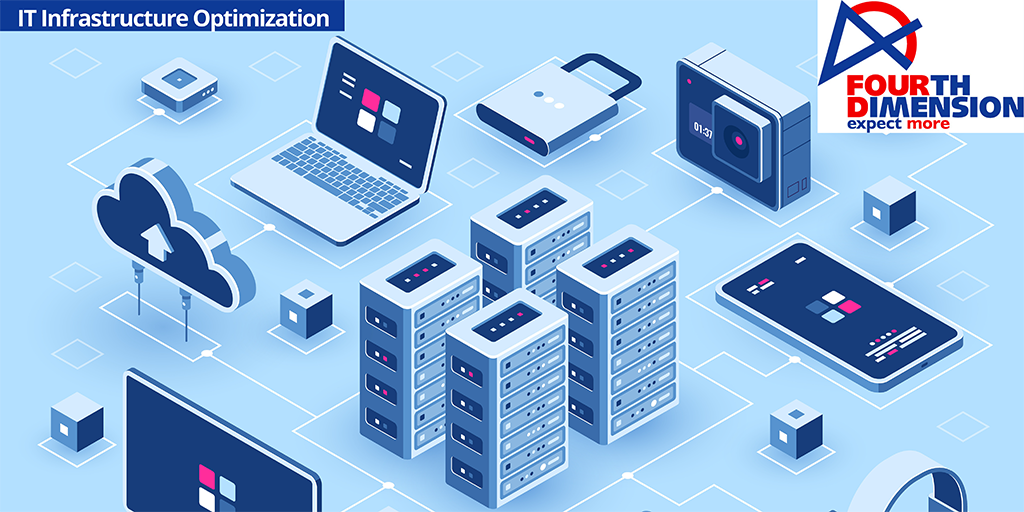IT Infrastructure Optimization
Infrastructure
As it goes with any capacity-building exercise, organizations must have a well-defined IT infrastructure optimization strategy to address the issues of over or under-investment in their IT.
IT Infrastructure Optimization is the process of reducing your overall spending by identifying underutilized resources, avoiding wasteful expenditures, architecting for peak loads and Right-Sizing computing services for scalability, and defining processes for day-to-day management.
When the demand for computing resources grows, cloud computing becomes more and more popular as a pay-as-you-go model, in which the computing resources and services are provided to cloud users efficiently.
Prioritizing IT Optimization is one of the MOST important actions for Non-profits where they are working on tight budgets. Regardless of the size of an NPO, the response to IT Optimization is akin to creating a more significant impact in society. In this current connected world, there's NOTHING gets executed without a stable technology back-bone while identifying digital initiatives that address:
- Operational Efficiencies
- Donors Engagement
- Accomplishing Funding Goals
- Governance, Compliance, and Security
- Meeting your Mission
However, choosing the right approach to optimizing your infrastructure can be a challenging task. You also need an experienced technology partner to design, plan and implement an optimization and transformation plan.
We present you the key benefits of IT infrastructure optimization, ways to optimize on-premise and cloud infrastructure, and more.
IT INFRASTRUCTURE OPTIMIZATION: 4 KEY TYPES
There are four main ways of IT infrastructure optimization:
- Taking stock of on-premise infrastructure – Complete IT Infrastructure Assessment
- Identifying the servers/software that have reached end-of-support
- Reviewing cloud infrastructure – Capacity vs. Utilization
- Migrating from on-premise to the cloud
Taking stock of on-premise infrastructure optimization
The most significant benefit of retiring the obsolete platform and optimizing on-premise infrastructure reduces the operational cost of running IT. However, there’s the possibility that you may end up compromising the performance of certain components.
The default approach to reduce/optimize on-premise infrastructure, businesses opt for cutting down the number of servers in their data centers. There’s a consensus that reducing the number of processors, going for less powerful processors (4 core instead of 8 core, for instance), or decreasing memory capacity may bring the cost operations significantly. However, all these ways of optimization may bring about some risks as well.
Let’s say your business platform runs on 15 high-end servers, which are expensive to maintain. You decide to optimize your IT infrastructure by cutting the number of devices to 10. Your system works fine, and you save 25% on infrastructure costs. But then you experience a sudden spike in fundraising that puts a load on your web traffic and payment gateway. Your platform experiences a peak load that 10 machines cannot handle. That, in turn, leads to downtime of your website and losing potential donors not able to remit the funds.
So, before optimizing your on-premise infrastructure, make sure that it will handle the load on peak loads throughout the year. I think your first step must be to conduct a comprehensive IT Infrastructure assessment that will throw a lot of insights into how IT resources are being used.
Identifying the servers/software that have reached end-of-support
This is another activity that takes back a seat because of several stakeholders involved in deactivating/decommissioning any server/platform from production services. The second important activity is to cost of maintenance, identifying the risks of running applications that are critical to the business.
Let’s say you have more than 5 servers that have reached an end-of-warranty and have to be decommissioned. The industry practice is to bring all stake-holder into a platform and explain the risk of running some applications on servers that are not supported by the vendor.
Once, there’s consensus amongst the key leaders of business, the following approach can be adopted for decommissioning.
- Take full archival of the data that are important to business from obsolete servers
- Consider maintaining archived data both off-line and on-line
- Communicate to all stakeholders, Users about decommissioning
- If the Data need to be migrated, then consider removing data duplicity & consistency
So, before decommissioning any obsolete infrastructure, make sure that you have the buy-ins from all leaders and take the necessary data backup to meet any compliance requirements.
Reviewing cloud infrastructure – Capacity vs. Utilization
Cloud infrastructure optimization is about assigning the right resources to balance the workload of applications and ensure that we allocate adequate capacity for optimum performance with minimum waste.
Every application or workload has unique infrastructure needs, and these needs can change over time. So, it is critical to match workloads with cloud resources.
We encourage you to conduct cloud audits once in six months for businesses that can achieve optimal performance, for apps to run better and require fewer resources to manage and less support.
To optimize cloud infrastructure, prepare a solution architecture that runs cloud infrastructure on demand. Thus, it is possible to stop or start cloud infrastructure whenever you need it automatically.
For instance, it is a common practice to launch an environment for a demo purpose. You pay for two hours you use the cloud instead of keeping it running the whole time.
Moreover, you can optimize your cloud expenditures by running a development environment only during the working hours of your developers. You can reduce the costs on the development environment by two times by running only during the office timings when developers are working.
You can also optimize the most expensive components of cloud infrastructure. This way, some infrastructure elements are running 24/7, and others run only at certain periods when required.
Migrating from on-premise to the cloud
Many organizations have already made a shift from on-premise to the cloud or at least have moved a part of their infrastructure to the cloud. Gartner states that the global public cloud services market is expected to reach $950B by 2026, up from $227.8B in 2019 which is almost 4 times of growth in four years.
Migration from on-premise to the cloud can help you save a lot. For instance, one of FourD’s clients, a global volunteer organization based in the USA, Chicago, was able to reduce the infrastructure and operations cost to more than 40% in 18 months.
There is no one unified approach to cloud migration. There are many cloud services options. However, they are all built around these main pillars of cloud transformation: Apps, Data, 3rd-Party Integration, Security Infrastructure, 24x7 Monitoring, and DevOps.
Cloud infrastructure brings a wide range of benefits. Let’s view them in more detail.
- Flexibility
Cloud vendors offer the concept of shared responsibility that provides flexibility and customer control. Your cloud vendor is accountable for hosting your operating system and overall infrastructure security, whereas you are responsible for scaling and the security of your cloud.
- Controlled level of responsibility
When businesses choose to host their data on the cloud, they benefit from managed services. This means that they entrust augmenting and optimizing their operational capabilities to a cloud provider. Thus, clients choose a level of responsibility they have over their infrastructure.
- Cost-optimization
Cloud cost optimization is the process of reducing your overall cloud spend by identifying mismanaged resources, eliminating waste, reserving capacity for higher discounts, and Right-Sizing computing services to scale.
As a result of shared responsibility and managed services in the cloud, you can cut operational costs. As the cloud vendor is responsible for security and hosting, you need fewer people to manage your infrastructure.
The benefits of IT infrastructure optimization are very tempting. But how to optimize IT infrastructure? What are the main stages? What can “IT Infra in a Box” offer to my NPO?
